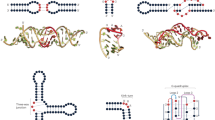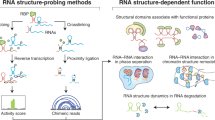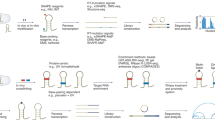Abstract
MOST sequenced RNAs have the potential to form secondary structures by means of local base pairing and loop formation. Arguments have been advanced that these structures are the result of evolutionary pressure, or of requirements for unique functions such as virus packaging1–7. To determine whether secondary structure is an intrinsic or anomalous property of RNA we have investigated random sequences generated by computer. These sequences, which contain no real biological information, can be arranged into thermo-dynamically stable secondary structures with about 50% base pairing. The results imply that one should expect a high degree of base pairing in RNA, consistent with early estimates of helical content in random copolynucleotides8 and the constraints accompanying structure formation in a hypothetical tRNA molecule9,10. Therefore, the mere existence of secondary structure does not necessarily implicate special biological functions, although the potential for functional interactions clearly exists.
This is a preview of subscription content, access via your institution
Access options
Subscribe to this journal
Receive 51 print issues and online access
$199.00 per year
only $3.90 per issue
Buy this article
- Purchase on SpringerLink
- Instant access to full article PDF
Prices may be subject to local taxes which are calculated during checkout
Similar content being viewed by others
References
Sanger, F., Biochem. J., 124, 833 (1971).
Fitch, W. M., J. molec. Evol., 1, 185 (1972).
Adams, J. M., Jeppesen, P. G. N., Sanger, F., and Barrel, B. D., Nature, 223, 1009 (1969).
Fiers, W., Contreras, R., DeWachter, R., Haegeman, G., Merregaert, J., Min Jou, W., and Vandenberghe, A., Biochemie, 53, 495 (1971).
Steitz, J. A., Nature, 224, 957 (1969).
Nichols, J. L., Nature, 225, 147 (1970).
Lodish, H. F., and Robertson, H. D., Cold Spring Harbor Symp. quant. Biol., 34, 655 (1969).
Doty, P., Boedtker, H., Fresco, J. R., Haselkorn, R., and Litt, M., Proc. natn. Acad. Sci. U.S.A., 45, 482 (1959).
Fresco, J. R., Alberts, B. M., and Doty, P., Nature, 188, 98 (1960).
Eigen, J., Naturwissenschaften, 10, 465 (1971).
Tinoco, I. O., Uhlenbeck, O., and Levine, M. D., Nature, 230, 362 (1971).
DeLisi, C., and Crothers, D. M., Proc. natn. Acad. Sci. U.S.A., 68, 2682 (1971).
Gralla, J., and Crothers, D. M., J. molec. Biol., 73, 497 (1973).
Uhlenbeck, O. C., Borer, P. N., Dengler, G., and Tinoco, jun., I., J. molec. Biol., 73, 483 (1973).
DeLisi, C., Biopolymer., 11, 2251 (1972).
Spanier, J., and Gelbart, E. M., Monte Carlo Methods and Neutron Transport Problems, 14 (Addison Wesley, Reading, Massachusetts, 1969).
DeLisi, C., Biopolymers, 12, 1713 (1973).
Min Jou, W., Haegeman, G., Ysebgert, M., and Fiers, W., Nature, 237, 82 (1972).
Gralla, J., Steitz, J. A., and Crothers, D. M., Nature (in the press).
Min Jou, W., Haegeman, G., and Fiers, W., FEBS Lett., 13, 105 (1971).
Ball, L. A., J. thoeret. Biol., 36, 313 (1972).
Ball, L. A., Nature new Biol., 242, 44 (1973).
Crick, F. H. C., Nature, 234, 25 (1971).
Author information
Authors and Affiliations
Rights and permissions
About this article
Cite this article
GRALLA, J., DELISI, C. Biological sciences: mRNA is expected to form stable secondary structures. Nature 248, 330–332 (1974). https://doi.org/10.1038/248330a0
Revised:
Published:
Issue date:
DOI: https://doi.org/10.1038/248330a0
This article is cited by
-
PepAnalyzer: predicting peptide properties using its sequence
Amino Acids (2023)
-
Salt-Promoted Synthesis of RNA-like Molecules in Simulated Hydrothermal Conditions
Journal of Molecular Evolution (2015)
-
Generation of Oligonucleotides Under Hydrothermal Conditions by Non-enzymatic Polymerization
Journal of Molecular Evolution (2014)
-
Complete nucleotide sequence of bacteriophage MS2 RNA: primary and secondary structure of the replicase gene
Nature (1976)



